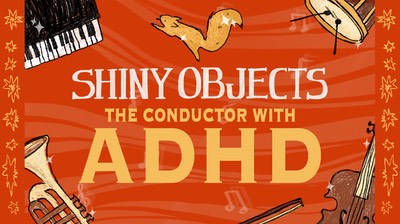At age 8, Mom asked me to go downstairs and fetch a scoop of food for Princess, our family pet. I penciled a rough sketch of a dog and bowl on a sticky note and stuck it to my forehead to remind me what I was supposed to do when I got downstairs.
My baseball glove laying at the bottom of the staircase caught my eye as I passed by; the smell of leather and dust was too compelling. As I turned around and bent over to pick it up, the sticky note fell off my forehead. Somehow, the rough pencil sketch had magically transformed into a vivid full colour image of a baseball glove and bat.
At age 12, I could stick two notes at a time to my forehead, which helped keep my mind on finishing simple tasks even in the midst of minor distractions. I simply put the task on one note, and the distraction on the other. When I was finished with one or the other, the remaining note would grab my attention. Unfortunately, if the task itself required two notes worth of sketches - "make your bed, do your homework, and write an apology to the teacher" - any interesting distraction that came along meant that one or more of the original tasks would be erased and replaced with the distraction.
Somewhere past my mid-teens I became suspicious that my teachers were giving more sticky notes to my classmates than they were to me. For example, no matter how carefully I listened in class, most assignments were marked “incomplete” for not including all of the work the teacher had supposedly asked us for (but they hadn’t asked, I swear they hadn’t). Band, Social Studies, and especially English; it didn’t matter what subject, the report card told the same story: “incomplete”, “pay more attention”, “stop fooling around". The bright spots were Phys. Ed. or any of the sports teams I was on. Those captured my full attention.
People with ADHD likely know where this blog is going. The rest may be thinking, “huh?”
Let me explain.
One of the executive functions of our brain is commonly called “working memory”: the ability to hold information in mind for a time while you use it to perform a task.
Think of working memory as having a wall in your brain where you can post sticky notes with sketched images or key words on them to help keep your mind on topic as you perform and complete a task. Once you are finished the task, you simply peel those notes off the wall and toss them away, making room for fresh stickies with information about the next task… or distraction.
As a typical functioning brain matures, it can hold more "sticky notes" to work with at any given time. As a bonus, that sticky stuff on the back of the notes gets upgraded to better quality so the notes can stick in your mind longer when you are fully mature. Not so with ADHD.
If we say that a typical mature brain can hold 6 or 7 sticky notes worth of information in working memory, then in comparison, ADHD brains would hold only 2 or 3 notes at best. Not only that, the ADHD brain never does receive the upgrade of sticky stuff, so most notes don’t stick around that long in an ADHD brain before falling off the wall. What’s worse, whatever sticky stuff they put on "boring notes" doesn’t even stick to that imaginary wall in the ADHD brain, making it virtually impossible to remember boring information long enough to turn it into an action.
Have you ever gotten off the couch to get a cold beverage from the kitchen; upon arriving in the kitchen you forgot why you were there? The sticky note fell off!! That happens to everyone once in a while, with ADHD, it can happen with annoying frequency.
This type of explanation is useful to understand why ADHD individuals find it hard to plan, perform, and complete boring or complicated tasks. ADHD working memory can’t work with as much information at one time as a typical functioning brain, nor can it hold onto that information for as long; that means we work best with less information and shorter durations. (especially for uninteresting topics)
Another ADHD phenomenon can also be explained with the sticky note scenario; if the ADHD individual is extremely interested in something, their brain may fill their entire quota of notes with the information necessary to pay attention to whatever they are currently locked onto (video games, sports on tv, a favourite novel), and their interest may be so intense that the notes seem to be stapled to the wall rather than stickied.
This hyper-focus can be frustrating for others who try to get the ADHD person's attention. Trying to post a new note like “take out the garbage”, “cook dinner”, or “change the baby’s diaper” is almost impossible when their attention has locked on, because their limited number of sticky notes are already filled with more captivating information, and their brain has stapled that topic in place. Removing the highly interesting stapled notes to make room for your notes takes considerably more time and effort than usual.
Common responses to hyper-focus (raising voices, punishing, consequencing, labelling, or abandoning) are confusing for the person with ADHD who wasn’t purposefully trying to ignore others. Also, those responses do little toward addressing ADHD interest-based attention problems; in fact, they worsen it because punishment, labels, and ostracism aren’t that interesting (to anyone).
There are ways to increase the ADHD person’s success in this area, but an understanding of the ADHD working memory is critical in developing personally tailored strategies which improve the person’s ability to successfully navigate the world around them.
* for a more complete explanation of how ADHD brains unconsciously gravitate to “interest” far more than “importance”, watch my podcast
“Attention, Interest, and Importance in ADHD"
